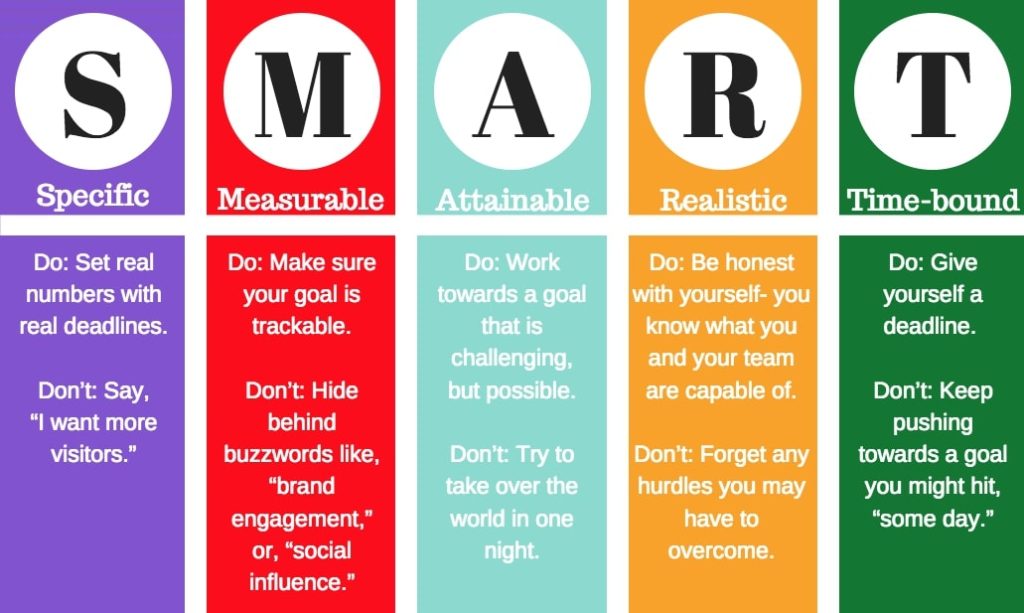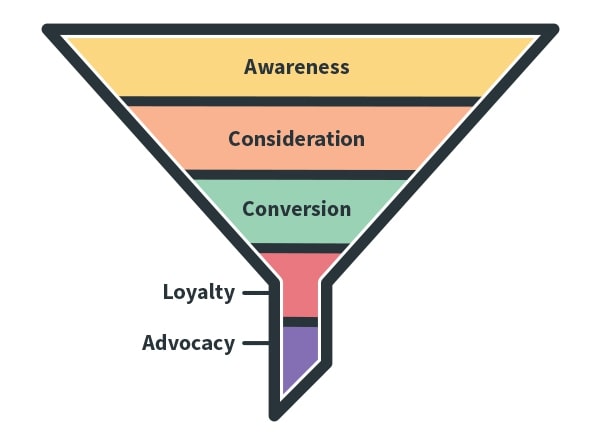
Not all marketing goals are created equal. Some goals produce the desired results, while others only stay on paper. That explains why 90% of businesses fail to meet their strategic goals.
The truth is that an objective is nothing without:
- An action plan to implement it
- A realistic timeline to achieve it
- A set of metrics to analyze its success
So, jotting down one-line goals will not cut it in such a competitive marketing landscape. Instead, you need the SMART goal-setting framework-an advanced technique to prepare your plans in detail and build a solid groundwork to achieve them.

This article will walk you through what the SMART method is, how you can map them to your marketing funnel, and eight critical SMART marketing goals you can leverage to up your marketing game.
Table of Contents:
SMART marketing goals: the what and why
Marketing is all about planning and implementing strategies that yield results. But all your strategies can fall flat on the face if you aren’t headed in the right direction.
How do you find the best direction to pursue? By setting proper business goals.
Once you’ve done all the legwork to chalk out your marketing plans, creating market segments is the best way to make an actionable roadmap and meet your short-term goals and long-term goals. You’ll come across many goal-setting best practices when listing down your targets-but the SMART Goals framework is one of the most widely tried-and-tested formulas.
Let’s take a closer look at what SMART goal setting is about and how you can adapt it for your business.
Specific
One of the most significant factors holding you back from reaching your marketing objectives is the lack of precision in your plans. Making a list of your aspirations is not enough; you have to write action-backed goals with a high degree of specificity.
By that logic, your goal to “increase website traffic” seems vague and less actionable. Instead, you can set a specific goal to “increase website traffic by 30% using Search Engine Optimization (SEO) techniques and pay-per-click (PPC) ads”.
Here’s a helpful checklist of questions to make your strategic goals more specific:
- What is the target?
- How will you quantify this target?
- How do you plan to reach the target?
- What resources will you need?
Making your business goals more specific to your future prospects ensures that your strategies are more targeted and action-oriented to achieve them.
Measurable
Let’s say you’ve set your goals, outlined some ways to achieve them, and started implementing your tactics. A month later, how do you figure out how far you’ve come in your journey towards these goals?
This is why it’s essential to quantify your goals and measure them with the right Key Performance Indicators (KPIs). A set of relevant metrics helps track your progress and assess whether your current strategies are working well or not-creating room for improvement.
So, if you want to increase your website traffic by 30% using SEO and PPC ads, you can use trackable benchmarks like the number of visitors, organic traffic numbers, blog traffic, and top traffic numbers, with Google Analytics for example.
Attainable
Good goals are realistically achievable instead of reflecting your ambition or guesswork. That’s why it’s important to assess the ground reality and perform meticulous research before you start setting targets.
Once you’ve done the research and prepared a list of goals, ask yourself: are these objectives feasible for you and your team? The answer will help you iterate any goals that don’t seem attainable. Instead of aiming for the impossible, it’s best to keep yourself grounded and scale slowly.
Remember: attainable is always better than aspirational.
So, if you don’t have the resources to carry out SEO tactics, your attainable goal would be to increase your website traffic by 15% using PPC ads.
Relevant
Now that you’ve jotted down a few goals, it’s time to look at the bigger picture and review the relevance of each goal for this vision.
Setting a meaningful goal and identifying its significance for your future is important to motivate your team’s work. Besides attaching meaning to each goal, prioritizing your targets will also help draw up the right roadmap to achieve them.
So, if the bigger picture for your business is building brand recognition, the goal of increasing website traffic would be more important than compiling an email list.
Time-bound
A SMART marketing objective is complete when you define the timeline for achieving it. Only when you measure your growth against a predetermined time horizon will you be able to see real and timely progress.
Here are some tips to help you set time-bound goals for your marketing strategy:
- Assign a priority level for all your goals based on the level of urgency and significance. Pick a shorter timeline for the top priority goal and gradually longer ones for the others.
- Divide each goal into weekly or monthly milestones. You’ll have a better idea of your progress that way.
Remember to spend extra time setting these timelines-unrealistically short timelines will only set you up for failure while longer ones would slow down your growth.
Why SMART goals matter
SMART marketing objectives help get rid of guesswork, bring more clarity and structure to your plans, and keep you on the right track to success with a durable strategy. Making your marketing goals, SMART can multiply your sales, increase profits, and a lot more.
Here’s why you need SMART marketing goals to reach your desired results:
- Better clarity of the common purpose: Instead of leaving your team in the dark, a SMART objective tells them exactly what to achieve while chalking out how and when. These goals eliminate any room for confusion and offer a clear direction for moving forward.
- Improve data analytics for metrics: The world is running on data and algorithms. With a SMART goal, you have the suitable KPIs to measure, analyze, and derive actionable insights for the future.
- Greater prioritization and efficiency: SMART goals can maximize your productivity and progress by giving you the correct sequence of priorities and timelines. So, if you have 10 goals to achieve, you have the best possible plan of action to fulfill them.
- Ease of tracking progress: Without a set of timelines and metrics to measure your growth, you’ll be clueless about how far you’ve come. A SMART goal tells you minute details about your progress-helping you revise your plans whenever needed.
In essence, setting and completing your targets is a lot easier when you use the SMART framework. It keeps you in control of all your work and tracks your progress at all times.
How to map your goals to your marketing funnel?

If you’re uncertain about setting SMART marketing goals, your marketing funnel is a great reference point to determine your goals, results, and metrics.
Your marketing funnel broadly includes these 3 stages:
- Top of the funnel (discovery): when people come across your brand for the first time. You want to appear in people’s searches, show up on their social media feeds, and pop up in ads.
- Middle of the funnel (consideration): when a prospect is considering a decision to purchase from you. You aim to improve lead quality, increase your ads’ clickthrough rates, and get more downloads for your free resources.
- Bottom of the funnel (purchase): when you convert the prospect and close the deal. You’re looking to maximize signups, increase consultation calls, and boost sales.
Based on your expectations from each stage of your funnel, you can define a SMART goal capable of achieving the expected results. Let’s dive deeper into 8 such marketing goals divided across these three stages of your funnel.
8 SMART goals for digital marketing
Picture this: you create a list of marketing goals at the start of each quarter and designate the timelines to achieve these targets. Despite all your careful planning and data-backed decision-making, you fail to achieve your goals in time or at all.
SMART marketing goals can be a gamechanger if you struggle to meet your targets.
Look at these 8 key digital marketing goals that you can consider for your marketing funnel and skyrocket your growth!
Discovery
The discovery phase is your chance to show up before your target audience with an efficient inbound marketing strategy. Here, your goals should focus on optimizing your online presence and creating value-added content marketing that attracts people when they discover your brand for the first time.
Increase website traffic
Greater website traffic can significantly improve your domain authority, enhance discoverability, and build brand awareness. It puts you in front of your audience-increasing your chances of converting them into a paying client.
When you get more visitors to your website, you can also gradually create your email list, build a social media following, and direct the visitors to product/service pages with suitable CTAs.
How to set a SMART goal?
Here’s how you can make this goal a SMART one:
- Specific: increase website traffic using [X] and [Y] techniques
- Measurable: increase website traffic by [X]%
- Attainable: increase website traffic with efforts from [X] and [Y] teams
- Relevant: increase website traffic to enhance search engine rankings
- Time-bound: increase website traffic by the end of the quarter
Enhance social media interaction
Your social media presence can unlock endless possibilities-from building a massive community and engaging with your customers to generating more leads and fueling sales.
But for many brands, social media marketing is unplanned and directionless. Without the right game plan in place, your strategies will fall through the cracks and end in disappointment. This is where setting SMART goals can work in your favor.
How to set a SMART goal?
Here’s how you can boost your social media strategy with a SMART goal:
- Specific: increase reach on social media channels, primarily Instagram
- Measurable: increase reach over [X] impressions and accounts
- Attainable: increase reach in a span of [X] days with ads and sponsored posts
- Relevant: increase reach on social media to enhance website traffic
- Time-bound: increase reach on social media within [X] days
Boost brand recognition
You want to put your brand before the right people and garner a level of popularity to generate more leads and increase your chances of conversion. Besides, your ideal target buyers should know that your brand is a viable option while considering a purchase decision.
While all your marketing strategies work towards building brand awareness, setting SMART goals would help in better targeting your marketing effort.
How to set a SMART goal?
Here’s how you can create a SMART goal for this:
- Specific: improve search engine rankings for 10 relevant keywords
- Measurable: check rankings and organic search visibility
- Attainable: improve rankings through high-value content, optimized pages, blog post, proper meta details, and a high number of backlinks
- Relevant: improve rankings to enhance discoverability and brand recognition
- Time-bound: improve rankings for 10 keywords within [X] months
Consideration
In the consideration stage, your prospects are contemplating a buying decision. It’s on you to convince them to make a purchase. So, your targets should relate to solving consumer pain points and building your brand authority through social proof.
Create an email list
Email marketing is one of the best ways to engage with your customers and prospects. You can create personalized emails, share the latest updates and announcements, and send discount coupons to establish a personal relationship with your subscribers.
With SMART goal-setting, you can spice up your email marketing efforts to optimize your results.
So, build an email list, research your subscribers, segment them strategically, create unique mailers for each segment, and augment the impact of your marketing campaign. This way, you can also explore new ideas to interact with your email audience.
How to set a SMART goal?
Here’s how you can set SMART goals for email marketing:
- Specific: boost sales through email by [X]%
- Measurable: analyzing subscriber data for open rates, click-through rates, and conversion rate
- Attainable: checking whether achieving less or more than [X]% is a possibility
- Relevant: increasing email sales to increase overall revenue and profits
- Time-bound: boost email sales within [X]%
Generate new leads
Almost all your marketing efforts-directly or indirectly-aim to get new business through regular lead generation.
Even though you might have a lead pipeline and a sale cycle, your strategies will not produce the desired results if you don’t have a goal to work towards. Setting financial targets is not for your marketing team to get enough leads.
You need a set of SMART goals to guide your team towards success and create a seamless lead-generating and sales prospecting workflow for your business.
How to set a SMART goal?
Here’s how you can create a SMART goal for this:
- Specific: increase the number of qualified leads by [X]%
- Measurable: keeping a tab on which channels the leads are coming from
- Attainable: reviewing if [X]% is feasible for the given timeline
- Relevant: increasing qualified leads to shorten the sale cycle and accelerate conversions each month
- Time-bound: increase the number of qualified leads within [X] days
Pro tip: You can also use lead magnets or digital products to add more people to your email list and push them down the funnel.
Increase ad ROI
The more leads you generate, the higher your revenue soars. Running ads is one way of accomplishing this.
The only catch is — you can see a good ROI for your ads when you continue running them for a decent time. So, you have to allocate a sizable part of your budget to ad campaigns. It’s disappointing to see no or minimal results after spending so many resources into running ads.
Planning your ad campaigns using the SMART goal framework allows you more time to evaluate and strategize.
How to set a SMART goal?
Here’s how you can set a SMART advertising goal:
- Specific: enhance ROI from PPC ads by [X]%
- Measurable: checking the conversion rate, cost per acquisition, and lead quality score
- Attainable: analyzing if [X]% increase is viable or not
- Relevant: enhancing PPC ROI for more sales and brand visibility
- Time-bound: enhance ROI from PPC within [X] days
Purchase
Your funnel’s final stage is about winning the leads in the pipeline and delivering a great post-purchase experience. Your goals for this stage should focus on closing all the deals faster and retaining the existing customers.
Improve customer satisfaction
Cultivating client relationships is an important marketing goal for any business. Establishing meaningful relationships through proactive customer engagement and satisfaction tactics, such as customer experience, can turn one-time buyers into repeat customers-building brand loyalty.
Happy and loyal customers indirectly function as your brand advocates, spreading positive word-of-mouth about your business. The right SMART goals can guide your customer servicing efforts and help you accomplish this target.
How to set a SMART goal?
Here’s how you can create such SMART goals:
- Specific: increase customer referrals by [X]%
- Measurable: checking the number of invites shared, clicks on referral page, and visitor conversion rate
- Attainable: assessing whether [X]% increase will work out sustainably
- Relevant: enhance referrals to create a positive brand identity
- Time-bound: increase customer referrals within [X] days
Maximize conversion rate
Your conversion rate tells you the proportion of leads you’re converting into customers. A high conversion rate equals more revenue and bigger profits. It can also mean expanding the customer base.
However, optimizing your conversion rate isn’t as straightforward as it sounds. Multiple factors-like competitor research, A/B testing, and quality of copywriting —determine the success of your Conversion Rate Optimization (CRO) strategies.
This is where setting SMART goals can help prepare the groundwork for your CRO tactics.
How to set a SMART goal?
Here’s how you can make a SMART goal for this:
- Specific: multiply conversion rate by [X] times using [A] and [B] techniques
- Measurable: calculating conversion rate
- Attainable: reviewing whether [X] times increase is realistically possible
- Relevant: enhance conversion rate to maximize sales
- Time-bound: multiply conversion rate within [X] days
Conclusion
It’s no surprise that marketers that set goals have a 376% chance of successfully achieving their goals. Just setting random targets is not enough. You need power-packed goals to fuel your efforts and guide you to success.
The SMART goal-setting framework is a great technique to outline your digital marketing goals. It zooms into your individual targets to spell out how you’ll get there. So, use this extensive guide to map your marketing activity goals to your funnel and set SMART goals to increase your success chances.
The post A Roadmap to Set SMART Digital Marketing Goals appeared first on Mention.

Leave a Reply